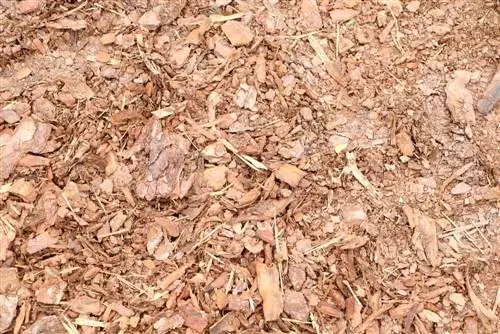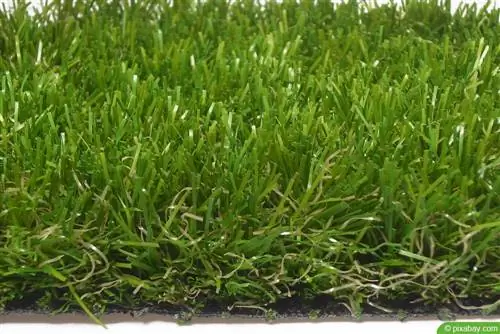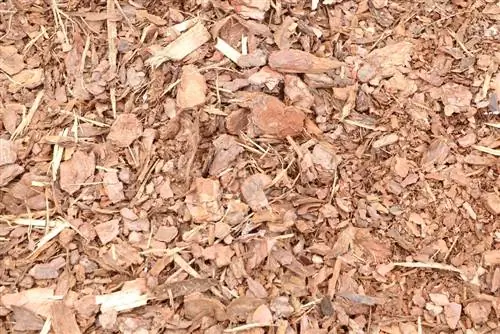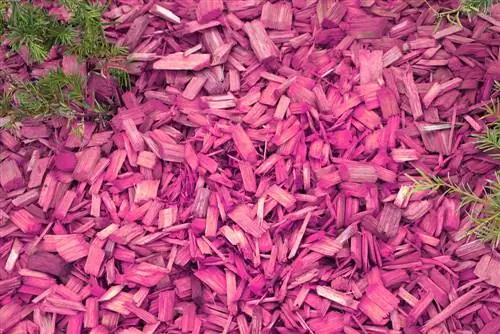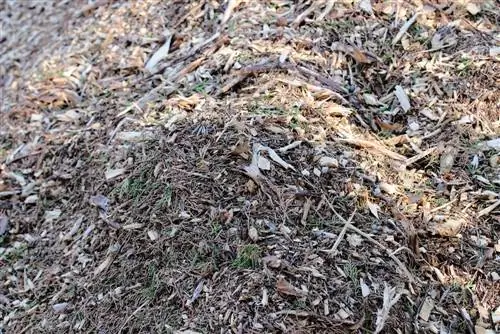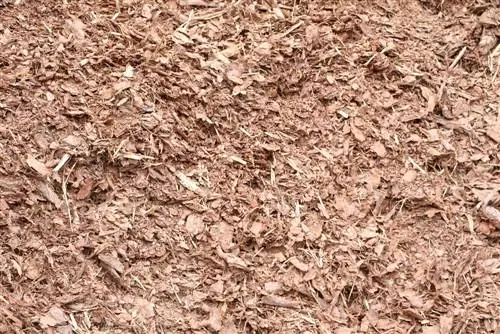- Author admin [email protected].
- Public 2023-12-17 03:39.
- Last modified 2025-01-24 12:45.
There are lively discussions about the advantages and disadvantages of bark mulch. While some hobby gardeners are convinced of its positive properties, other garden owners are becoming more and more doubtful. In certain circumstances and in specific situations, mulching can bring many advantages, but the disadvantages cannot be ignored. To form your own opinion, just try this method yourself.
Disadvantages
Purchased products come with a number of disadvantages that you should weigh against the advantages. But even self-made material can have negative consequences.
Robbes sunlight
If you spread bark mulch on areas that have been planted with young plants, a large part of the sunlight does not reach the tender shoots. They are covered and shaded by the dense layer of small chopped pieces of wood. To protect delicate plants, you should consider alternatives:
- cover with a loose layer of straw
- Lay out spruce or fir branches
- use transparent garden fleece
Attracts snails
Bark mulch offers unwelcome guests a safe shelter, which the feeding pests like to use to lay their eggs. This is particularly the case in the later stages of rotting, when the pieces of wood have absorbed a lot of moisture and are slowly falling apart. If you cover the same beds with a layer of mulch every year without replacing the old substrate, the living conditions for snails will be further improved. Be sure to keep the environment as dry as possible:
- Work decomposed residues into the substrate or remove them after three years at the latest
- Loosen the soil deeply so that precipitation can seep away
- use dried bark mulch
- mulch on warm and dry days
- do not mix fresh mulch with soil
Ineffective on root weeds
If your garden is overgrown with couch grass or groundweed, bark mulch is of little help in controlling these stubborn root weeds. They have developed strong rhizomes and stolons that spread underground. The plants prove to be competitive and grow even under low-light conditions. Fresh shoots quickly appear between the bark mulch. To combat root weeds, planting with strong-growing ground cover plants has proven to be successful:
- Small Caucasian comfrey (Symphytum grandiflorum)
- Balkan cranesbill (Geranium macrorrhizum)
- Alpine elf flower (Epimedium alpinum)
Intolerances
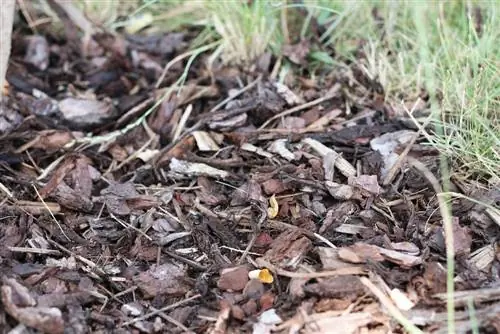
There are hardly any plants that react sensitively to bark mulch. The widespread assumption that bark mulch leads to soil acidification has not been proven by scientific studies. Even if you mulch the same bed for many years, no significant effect will be visible. The assumption comes from the fact that bark mulch often comes from conifers. The material itself has an acidic pH value, but this is neutralized through decomposition. Not every bed can tolerate bark mulch. Here you should avoid a layer of mulch:
- Groundcover
- freshly planted plants that have not yet developed a pronounced root system
- shallow-rooted plants
- warmth and drought-loving species
- alpine plants on gravel and stone soils
- Vegetable patch
Unprotected label
The term bark mulch gives no indication of what the product is made of. There are currently no legal regulations defining the composition. It may be that cheap bark mulch does not consist of bark but entirely of foreign substances. After all, the ingredients must be of plant origin.
Tip:
Look out for the seal of the Quality Association for Substrates for Plants. V., because these products must be made of bark.
Cadmium
The highly toxic heavy metal occurs naturally in soil and rock. In forests with acidic soil conditions, cadmium is dissolved so that pine and spruce trees absorb the chemical element through their roots and store it in their bark. Since softwoods are predominantly used for bark mulch, various products can be contaminated. Since 2014, products with a cadmium content of more than 1.5 milligrams per kilogram have not been allowed to be brought onto the market. However, if used over a long period of time, the heavy metal can accumulate in the garden soil and get into crops.
Note:
When purchasing, pay attention to information about the cadmium content and the RAL quality mark. Award-winning products have been tested for toxic heavy metals.
Spread of fungi
Since products with the RAL quality mark are untreated natural products, the pieces of bark are usually contaminated with fungal spores. They are part of the natural ecosystem in the forest and permeate the mulch with their fine mycelium because they are involved in the decomposition of the material. Small temperature fluctuations and consistent humidity promote the growth of fungi. Although the visible fruit bodies are only a sign of advanced decomposition processes, this property gives bark mulch a bad reputation among many hobby gardeners. However, the fungi are not harmful because they do not colonize living parts of plants. Remove the fruiting bodies along with the bark mulch if these typical fungi disturb the aesthetics:
- Yellow tan blossom with a chewy consistency
- typical fruiting bodies of cap mushrooms
- various types of ascomycetes
Advantages
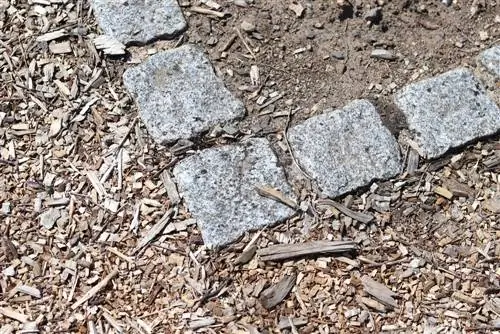
To benefit from the benefits of a layer of mulch, you should pay enough attention to the bed. If you leave the bed to its own devices, natural degradation processes will quickly set in and the positive side effects will be lost.
Prevents dehydration
A thick layer of dried pieces of bark acts as an evaporation protection. It ensures a balanced microclimate on the top substrate layer. The wood absorbs the sun's rays and heats up. The thicker the layer, the less heat penetrates to the ground surface. This prevents excessive water from evaporating. The soil stays moist longer, protecting plants from drying out during dry summer periods.
- significantly reduced water consumption in the garden
- less maintenance effort
- natural water cycle is established
Looks aesthetic
Choosed correctly, bark mulch contributes to the visual enhancement of your garden. Whether the appearance improves the aesthetics depends on personal taste and grit. You can make your bed look natural by using bark mulch with pieces of bark and branches of different sizes. This look resembles natural habitats in forests. For a structured effect, use uniform material:
- Flower boxes and plant pots are highlighted by finely grained pieces of bark
- medium grain is recommended for borders and small beds
- Only cover rock gardens in places with medium-sized pieces of bark
- large areas are covered with coarse-grained material
Suppresses weeds
Seeds of weeds spread by the wind fall between the coarse pieces of bark and do not come into contact with the substrate. If seeds have already accumulated on the substrate, they lack light to germinate due to the mulch layer. If a dark germinator manages to develop roots and cotyledons, the young shoots have little chance of growing through the bark layer. When buying bark mulch, pay attention to the grain size and use natural products that have a growth-inhibiting effect on weeds because of their plant substances:
- Conifer bark is rich in resins and essential oils
- Pine bark contains a particularly high amount of tannic acid
- Mulch layer should be at least five centimeters thick
Protection from environmental impacts
Bare soil is exposed to environmental conditions as long as it is not yet covered by plants. When hail and heavy rain hit the surface, the top layer of substrate is destroyed and soil is washed away. Strong winds carry away the soil over a long period of time, leaving the fine roots of young plants exposed and dry out. Bark mulch provides a protective layer against the effects of environmental influences. The protective function is also evident in winter, as the mulch layer then serves as insulation against frost and cold. The pieces of bark do not conduct heat and thus have a temperature-balancing effect. In order for this protection to work optimally, you must take the following aspects into account:
- Renew the mulch layer regularly
- Fresh pieces of bark occasionally
- pay attention to dryness
Nutrient supply
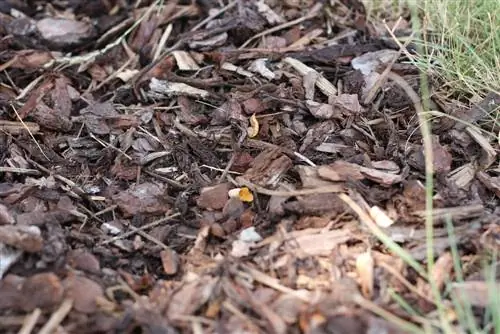
The pulp is decomposed by the organisms living in the soil. This process takes different amounts of time and depends on the grain size of the bark pieces. In order for the soil organisms to work actively, they need a lot of nutrients. Nitrogen plays a particularly important role in their metabolism. The soil may temporarily suffer from a nitrogen deficiency as this chemical compound becomes fixed. In the long term, however, nutrients are made available to plants when the bark mulch is broken down into humus. In this way, the soil is activated and a natural nutrient cycle is created:
- Soil organisms reproduce through released nutrients
- Plants can absorb nutrients through their roots
- no additional fertilization necessary
Tip:
To prevent nitrogen deficiency, you should spread horn shavings on the substrate before mulching. The animal material is a long-term fertilizer and supplies the soil with nitrogen.
Make your own bark mulch
Although you can find a large selection of bark mulch in garden stores, you can save yourself the money. When cutting hedges and trees, a lot of material is produced that can be chopped into small pieces and used for mulching. This method not only makes economic sense, but also offers ecological advantages. You run no risk of bringing harmful fungi and pathogens into your garden. Green waste is recycled and you ensure that no nutrients are lost. If there is no need for pruning in your garden, you can use other alternatives:
- dried grass clippings
- dry straw
- Mulch film or cardboard

